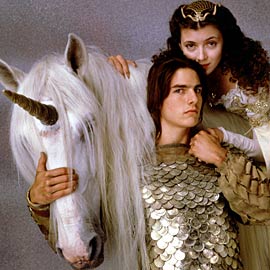 “O where have you been, my blue-eyed son/And where have you been, my darling young one?” So begins Bob Dylan’s great protest song, “A Hard Rain’s A-Gonna Fall,” which is featured poignantly in the new film Born on the Fourth of July.
“O where have you been, my blue-eyed son/And where have you been, my darling young one?” So begins Bob Dylan’s great protest song, “A Hard Rain’s A-Gonna Fall,” which is featured poignantly in the new film Born on the Fourth of July.
Born on the Fourth of July, like Dylan’s song, is a great American ballad. But its stanzas have the cadence of bitter disillusionment and its words are written in blood. It is based on the 1976 book by Ron Kovic, who recalled his life growing up in a small town (he really was born on the Fourth of July in 1946), where little boys played war games in the woods, “dreamed that some day we would be men,” and did not notice that the veterans marching in the July 4th parades would flinch when firecrackers went off.
Kovic joined the Marines when he got out of high school, and left for Vietnam as a virgin, in many ways. A bullet caught him and made him a paraplegic, paralyzed from the chest down. When he returned to the United States, he passed through a hellish rehab center, an uncomfortable return to his hometown, a confused flight to Mexico, and involvement in the anti-war movement.
Oliver Stone wanted to make a film of Kovic’s story as early as 1978, but a version starring Al Pacino was canceled just before shooting was to begin. Stone, then a writer trying to get his directing career off the ground, swore to Kovic he would get the film made if he ever had the clout.
Now, after Platoon and Wall Street, Stone has the clout. And Born on the Fourth of July has everywhere in it a similar sense of commitment, particularly in its lead performance. Tom Cruise plays the blue-eyed son, Kovic, from gung-ho high school student to political activist.
Cruise is amazing in this film. I don’t know the last time I was this surprised by a performance. Except for his slick turn in The Color of Money, Cruise never resembled much of an actor. Here he seems to be working from some deep, heretofore untapped reserve of feeling, culminating in a bitter scene in his parents’ house, after he has been hauled home from a beer-fueled bar fight. The degree of despair in the scene is terrifying.
The rest of the huge cast is satisfactory, and Stone has thrown in some vivid cameos: Eerily, his Platoon sergeants, Tom Berenger and Willem Dafoe, turn up in intriguing small roles, and the late Abbie Hoffman appears briefly as a campus rabble-rouser during Kovic’s days of radicalization.
Stone directs the film with his customary white-hot fervor, treating each new episode as another passage through hell. Stone is frequently guilty of overstatement, he leans on period songs for knee-jerk reactions, and he’s guilty of using caricatures to make a point (why does he have to have Kovic’s brother sing “The Times They Are A-Changing” on the eve of Kovic’s departure for Vietnam?).
But there are certain things Oliver Stone does better than anybody, especially when it comes to capturing a sense of helplessness and chaos. Amid the fury, the film has many moving small moments, as when Kovic, in his parents’ all-American back yard, quietly tells a fellow vet, ”I’d give up all my values to be whole again,” or his tears when he goes to bed with a Mexican prostitute.
If the movie is imperfect, it is because Stone and Kovic (who wrote the script together) have rage, passion, and a story to tell. It is a story of victory, though Kovic’s triumph is not that he wrote a book or spoke at the 1976 Democratic Convention, but that he has attempted to understand his life. That is worth a lot.
First published in the Herald, January 7, 1990
Stone has wandered so far away from popular success and critical respectability that he seems to be rarely considered at all these days. For all his failings, I still appreciate his free-swinging, sometimes reckless style – you have to have these kinds of filmmakers around. Cruise is excellent in the part, better, certainly, than Pacino would have been; watching the all-American boy becomes radicalized is a spectacle that outpoints Stone’s lack of subtlety.



 Posted by roberthorton
Posted by roberthorton 



